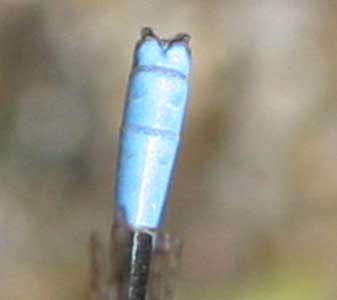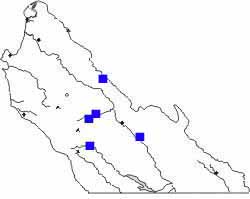CALIFORNIA
DANCER
Argia
agrioides
|
|
California Dancer is a common dancer of the
arid interior foothills. With a close look at the legs (as we have
above with digital photography), note that the length of the leg spines
is decidedly longer than the distance between the spines. This helps
identify this damsel as a dancer and not a bluet. Dancers are also
larger than bluets and tend to sit on the ground or rocks instead of
clinging to reeds like bluets.
|
|
|
There are two widespread dancers in MTY: Vivid
Dancer — which I think of as the 'woodland' dancer — and California
Dancer, which prefers the open grasslands and rocks. Both breed in
nearby water but they are not restricted to the streams themselves as
are, say, Sooty and Emma's Dancer. California Dancer lacks the black
triangles on the sides of the abdominal segments that are so typical of
Vivid Dancer, and has a black side-stripe on the thorax that is usually
forked. It is also very much a pale blue-and-black dancer, while Vivid
Dancer is a richer blue, sometimes bluish-violet, color.
Photos (above) 30
July 2006 Lopez Canyon, just W of Pinnacles NM
Photos (below) 5 Aug 2006 Arroyo Seco Lakes vicinity
|
|
|
| California Dancer is essentially identical to
Aztec Dancer A. nahuana, a widespread southwestern dancer.
Aztec Dancer has not yet been recorded in MTY but that seems likely to
occur, given that there are records for adjacent San Benito County. |
|
The differences between
California and Aztec Dancer are in the male appendages. There are
several distinctions that may be seen with a 10X lens in-hand or,
possibly, with close-up digital photography. Perhaps the most apparent
involve the tori at the base of the male's superior appendages. Seen
from above, the distance between the two tori is about the same as the
width of each torus on California Dancer (right). On Aztec Dancer, the
gap is less wide than either torus.
Note than on all the photos of
male California Dancer, the entire 8th, 9th and 10th abdominal segments
are blue. Bluets and forktails don't have this much blue at the end of
the 'tail.'
|

|
|
|
Photo (above) 5 Aug
2006 Arroyo Seco
Photo (below) 30 July 2006 Lopez Canyon
|
| Females come in blue andromorphic or tan
gynomorphic patterns (those shown in tandem ovipositing, farther down
this page, are gynomorphs). Immature males start out rather like
females in color, and gain their sky-blue color as full adults. This
one (below) still has a mostly pale violet upper thorax. |
|
|
| California Dancers oviposit in tandem, often with
the male in the 'sentry' position (below). It this shot he looks to be
leaning into the wind . . . this shot could be labeled "I am King of
the World!" Probably only makes sense if you've seen the movie Titanic. |
|
|
|
Photo (above &
below) 9 Sep 2006 Arroyo Leona, FRE
|
|
|
In a small trickling stream through arid
foothills, where ovipositing spots are at a premium, one might find
several pairs congregating at the same place for the same purpose. Four
are shown in the shot above, taken in the dry Coast Range foothills of
Fresno County. If you look closely at the female in the shot above this
one, you will see little black 'beads' attached to the underside of her
abdomen. These are not part of the dancer but are the larvae of
parasitic water mites.
|
|
 The map shows a selection of
locales at which California Dancer has been found. It is likely common
throughout the arid interior foothills of the county. As yet there are
no records anywhere near the foggy coast. The map shows a selection of
locales at which California Dancer has been found. It is likely common
throughout the arid interior foothills of the county. As yet there are
no records anywhere near the foggy coast.
In MTY, the known flight dates stretch from
12 May to 9 September. Elsewhere in California, flight dates span April
through November (Manolis 2003).
|
|
Literature cited:
- Manolis, T. 2003. Dragonflies and Damselflies of
California. Univ. of Calif. Press, Berkeley.
Web resources:
Major identification web sites with much information on California
odes include:
For sites with excellent photos to compare for identification or to
simply
enjoy, see:
Many of these sites have links to other useful pages. Kathy Biggs's
site
is particularly useful in her selection of links. |
